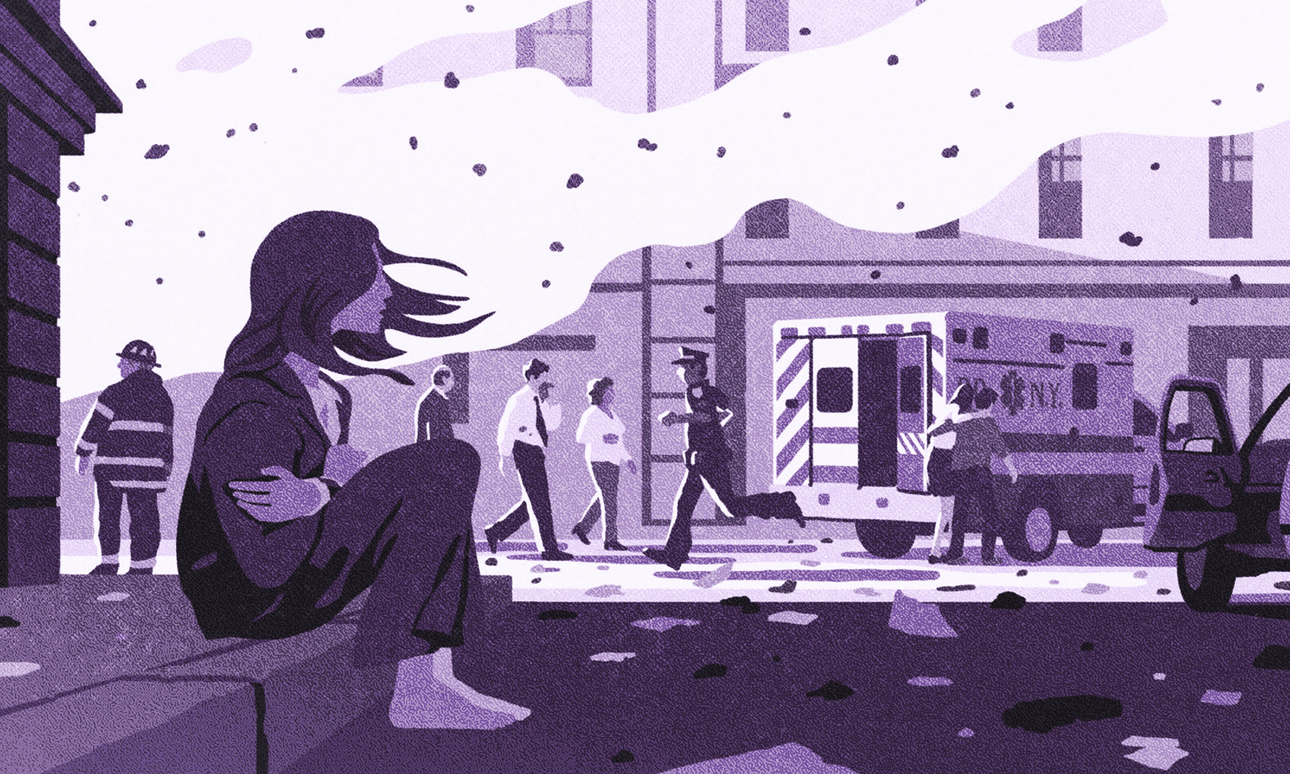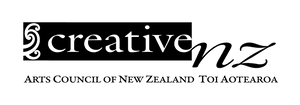Twenty years ago, Rae Lamb was in Manhattan preparing for a health fellowship. When a plane flew into one of the towers, she rang the newsroom back in New Zealand.
The Sunday Essay is made possible thanks to the support of Creative New Zealand
Original illustrations by Ross Murray
Mention 9/11 and most people respond by telling you where they were on the day. It’s one of those events that people remember quite clearly. And in quite a bit of detail. My whānau and I are no exception.
I was at a meeting in Manhattan, on the Upper East Side by Central Park. I had left my husband and sleeping 10-year-old in the hotel in Midtown so I could attend the first day of orientation to a one year Harkness Fellowship. We had spent the weekend as tourists in New York, including a visit to Wall Street and the financial district where we gazed at the twin towers. On that sunny morning of 11 September 2001 our biggest concern was missing out on a Yankees/Red Sox baseball game due to torrential rain the night before.
Twenty years on and my memories of the day are still acute. Our meeting had barely begun when we were interrupted and told a plane had flown into one of the towers. My first thought was that it was a small plane. It seemed beyond comprehension that it could be a commercial jet filled with passengers and deliberately flown into one of New York’s tallest buildings. Switching on the news and seeing the truth of it on the television, there was the growing realisation this was something big and horrible and it was not over.
Phone calls quickly followed. First to the family in mid-town, to check on them. Then waking the family in New Zealand in the middle of the night to say we were safe. Roused from sleep they had no idea what had happened. When I rang the Radio New Zealand newsroom in Wellington, the overnight subeditor was surprised to hear they had a reporter in New York. I told her I would go downtown to see what I could find out.
It’s around 15 years since I quit journalism. 2001 was meant to be a year out, completing the fellowship as a health researcher. But the news instinct kicked in. It drove me on that day, just after the second tower fell, to head downtown with a colleague to witness and report on what was going on. For my husband, also a journalist, it was a day spent in Midtown, not that far from it all, supporting our daughter whose request for waffles for breakfast switched to asking whether Afghanistan and the United States were at war. He had to turn off the television as it was distressing her. For a 10-year-old from New Zealand it was unfathomable.
Enduring images of the walk down Manhattan include main streets without traffic where previously it was difficult to cross the road. People sitting outside buildings looking at useless cellphones, cars parked haphazardly with the doors open and radios on as everyone sought information. No one seemed to know what to do or where to go. Some found solace in the churches, lighting candles.
As we got further Downtown the pedestrian traffic grew, increasingly dishevelled, distressed people heading up town. We spoke to a priest who told us people had jumped from the buildings, and of efforts to find any survivors. We started to get a sense of the horror ahead.
When the US airforce flew over, we were all frightened and ducked for cover. No one initially knew if it was another attack.
After bluffing our way through the cordon being set up at Canal Street, my colleague and I found a street corner with a working public phone booth, a few blocks back from where the towers once stood. There was lots of debris scattered around, including ash, papers, and shoes.
Rescue teams were setting up a staging post there. They kept coming, hoping to find police and fire service colleagues who had responded before the towers fell, as well as people from inside the towers. Ambulances and paramedics sat waiting for patients who never came, and we heard there were similar scenes at the hospitals where people were queuing to give blood that wasn’t needed. As the day went on it quickly became clear there was no one to rescue – the few survivors had already escaped.
The power was out and it was hot. Local store owners and residents distributed bottles of water and apples. The news from those coming back from ground zero kept getting worse. A fire chief handed out paper face masks but didn’t have enough for everyone, so gave them mostly to the women, including my colleague and me. Putting a mask on again for the first time in last year’s lockdown reminded me of that day when the unseen enemy was asbestos dust rather than Covid-19.
It was pure journalism – hear it, see it and report it. No time, nor the tools to write it down. No chance to check and verify the information with multiple sources. Cellphones didn’t work so I took turns in the queue with rescue workers and locals to use the phone. Every time I got through, RNZ put me live on air.
For much of the day, a shoeless woman, in a dust covered suit, kept us company. She said she was all right, having escaped from one of the towers early. Knowing more now about trauma, thanks to my current role, it’s clear she was in shock. She didn’t seem able to leave and just sat on the kerb for hours before disappearing during the afternoon. I wish I knew what happened to her.
At one point we heard another explosion and the fire crew yelled at us to run back another block. Another building, 7WTC, had come down. It had been burning all day
By evening, heavy machinery had arrived along with reinforcements for the exhausted and devastated rescue crews. It was clear that anyone who was going to get out was already out. The would-be rescuers were unable to help as they wanted to, and many of their colleagues were missing. We decided to leave, knowing we wouldn’t get back through the cordon. As we walked uptown in growing darkness we were saddened to see the impromptu noticeboards that had sprung up, covered in photographs and messages as people began to search for missing loved ones. We were appalled to see street vendors already hawking bits of rock they said had come from the towers and postcards of what used to be.
At Midtown the subway was running. A fellow passenger warned us we might have been exposed to asbestos. When I got back to the hotel, the first thing I did was bag and seal my clothes and shower, before catching up with the family.
It took us three days to get out of Manhattan and return by train to Boston where we were to spend the year. We thought hard about going home to New Zealand. Just as it must be for those caught overseas during today’s pandemic, home seemed the safest option in an uncertain world.
We chose to stay on. In many ways it was a strange year. American flags were everywhere in the immediate aftermath. Our daughter had to swear allegiance to the flag at school. She felt uncomfortable, given she came from somewhere else. In the days that followed, Sikh taxi drivers talked about their fear, based on experience, of being targeted and abused. It took me many months to get on a plane again. When I did, flying was much less of a pleasure, with the ramping up of the security measures we all take for granted now. I still remember my 10-year-old being physically searched in public at a US airport without either parent allowed to support her, when we travelled to spend Christmas with friends in Memphis.
Looking back now, after all these years, moments of kindness and human empathy also stand out. On our return to Boston my daughter started school and her teacher, a stranger, asked how we were. I burst into tears. Now I know why it meant so much. The importance of asking people if they are OK and caring about the answer has been so very evident as we in New Zealand have navigated our way through other life shattering events such as the Christchurch earthquakes and the mosque attack. Most recently the pandemic. We have all learned something about the kindness of strangers.
As we mark the 20th anniversary of 9/11, my family and I will think about those who died, including the rescue workers who later succumbed to asbestos related illness. We hope the years since have been kind to their friends and families.
I have returned to New York three times since 9/11, but I have never returned to ground zero. A few years ago, my daughter visited the memorial where the twin towers once stood. She tells me it is very moving and has been thoughtfully done. I am glad she went but I will never go back down there myself. Twenty years on it still feels like a grave site. This was the last big story I covered as a journalist. People say it must have been the story of a lifetime. It will never feel like that. So many people died.
Rae Lamb is chief executive, Te Pou and Blueprint for Learning, and was formerly deputy health and disability commissioner and a journalist.
Read more in the Sunday Essay series here

